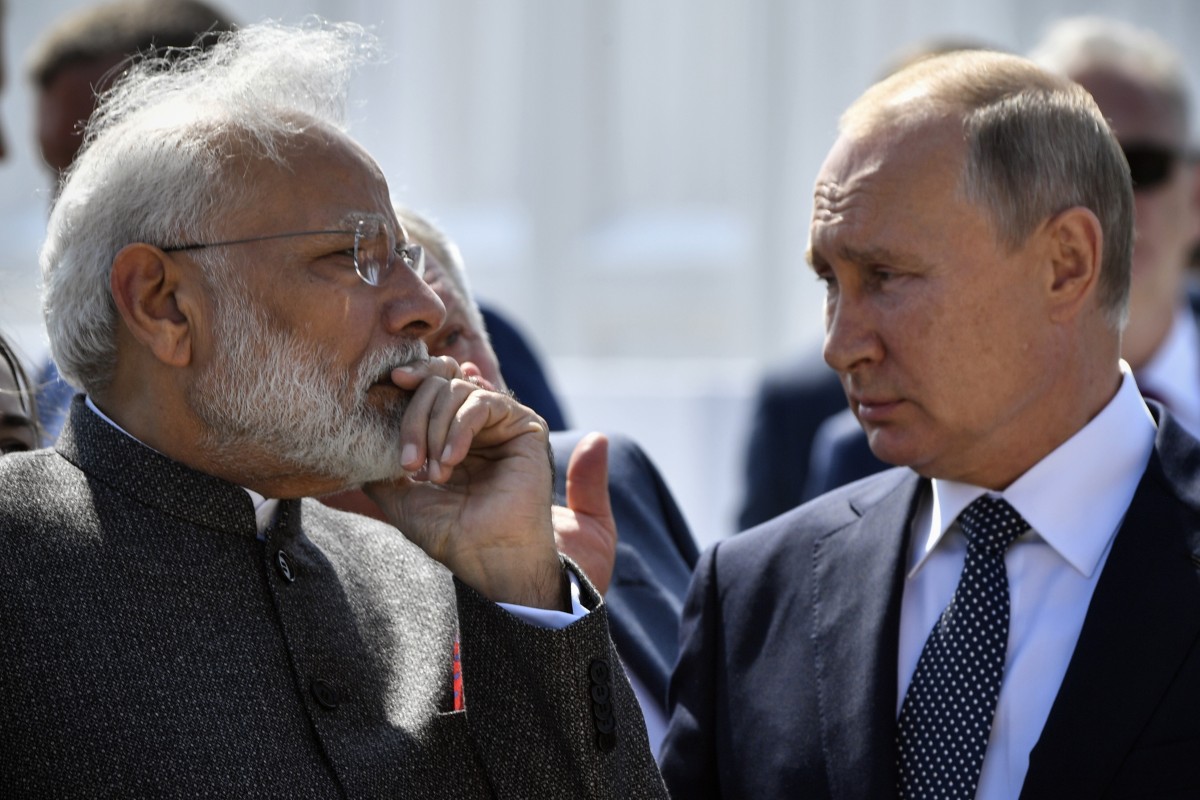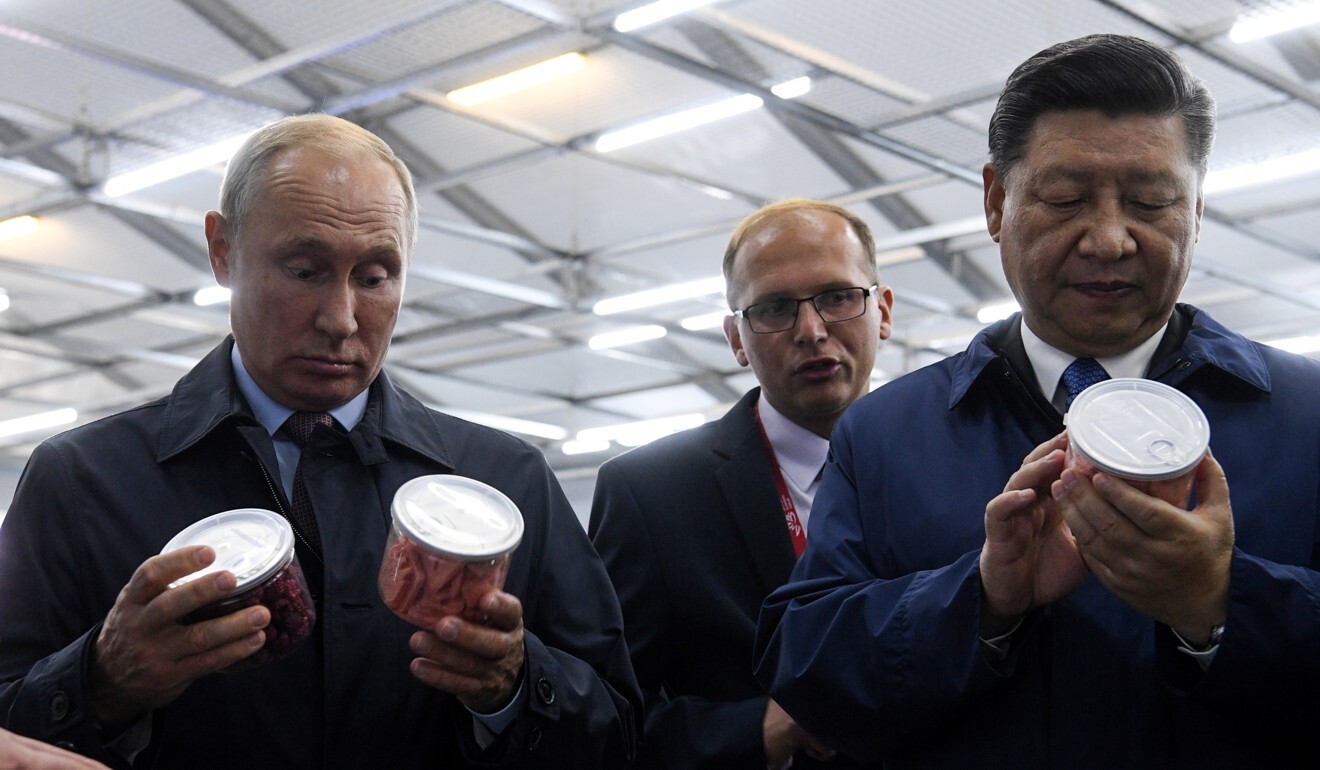 Indian Prime Minister Narendra Modi and Russian President Vladimir Putin chat while visiting a shipyard outside the far-eastern Russian port of Vladivostok on September 4, 2019. Photo: AP
Indian Prime Minister Narendra Modi and Russian President Vladimir Putin chat while visiting a shipyard outside the far-eastern Russian port of Vladivostok on September 4, 2019. Photo: AP
India has a difficult foreign policy problem on its hands. While New Delhi would like a balance against Beijing in the wake of recent tensions, it also prefers to remain non-aligned in China’s geopolitical rivalry with the United States in the Indo-Pacific. In a bid to solve that quandary, India has turned to an unlikely quarter: Russia.
In June, Indian Defence Minister Rajnath Singh used a trip to Moscow for a delayed Victory Day parade to urge Russia to expedite the delivery of defence equipment. Then, India’s ambassador to Russia floated the idea of Moscow participating in the Indo-Pacific initiative.
With the idea having gained currency among many strategic analysts in New Delhi, India mooted the possibility of Russian involvement in a trilateral engagement with Japan. But that’s just a start; India and Russia will have their annual summit in October and chances are that the Indo-Pacific will feature on that agenda.
By pulling Russia into the Indo-Pacific, India hopes to escape making tough choices in the US-China face-off. New Delhi is also trying to induce a split between Russia and China by appealing to shared interests over freedom of navigation in the South China Sea and the Indian Ocean.
Among other initiatives, India and Russia are currently working on a
sea route from Chennai to Vladivostok, the success of which would depend on peace in the South China Sea.

China ends fishing ban in South China Sea, raising fear of potential conflicts among fishermen
China ends fishing ban in South China Sea, raising fear of potential conflicts among fishermen
If Moscow can be convinced that Chinese aggression is a threat, New Delhi believes it will become a useful partner in the Indo-Pacific. The presence of another major military power, capable of providing a balance to the US and China, will help turn the bipolar geopolitical battlefield into a multipolar arena – with greater space for middle powers like India itself.
But this line of reasoning is problematic. For India’s plans to work, Russia must see possible Chinese hegemony in the Indo-Pacific as a threat – the same way India, the US, Australia, Japan and others do.
Yet, the odds are stacked against New Delhi. Take China’s economic influence over Russia, for instance: China has been Russia’s largest trading partner for up to a decade. In 2018, China accounted for over 15 per cent of Russia’s total trade.
With the Russian economy wilting under Western sanctions and Covid-19 wreaking havoc, Moscow will only become increasingly dependent on Beijing.

Russian President Vladimir Putin and his Chinese counterpart Xi Jinping inspect freeze-dried fruit and vegetables at The Far East Street exhibition on the sidelines of the Eastern Economic Forum in Vladivostok on September 11, 2018. Photo: AFP
But far from fearing Chinese influence, Russia has in fact stepped up collaboration on an ever-growing list of common interests in recent years. In different parts of the world, China’s economic might has complemented Russian military presence.
In Syria, for instance, the two countries have often spoken in one voice – and Russia’s military offensive in support of Syrian President Bashar al-Assad has run parallel to Syria’s
deepening economic ties with China.
Similarly, on Iran, both countries have been countering the US. Just this month, they voted against a US proposal in the United Nations Security Council to extend a weapons ban on Iran. Shortly afterwards, the two countries launched a joint effort to organise a summit on the Iran nuclear issue – one that US President Donald Trump has said he is unlikely to attend.
And while China has helped prop up the Russian economy, Russia has been helping build up China’s own military prowess: Russia supplied as much as 70 per cent of China’s arms imports between 2014 and 2018, a clear sign of deepening strategic convergence between the two countries.
The growth of China's military power over the past 40 years
The growth of Chinese military power over the past four decades
With this growing convergence of interests, Moscow will only see Chinese influence in the Indo-Pacific as a bargaining chip against the West. Russia has not as yet objected to Chinese territorial claims in the South China Sea – and it has no reason to. If anything, Russia’s own neighbourhood policies merely mirror those of China: it asserts historical claims, even in violation of international commitments.
Russia’s annexation of Crimea – and its increased militarisation on the frontier with Eastern Europe – is no different from China’s own policies in the South China Sea.
For India, by contrast, Russia’s entry into the Indo-Pacific would prove counterproductive – not least by infuriating and compromising New Delhi’s allies in the region.
Take the Quad, comprising Australia, India, Japan and the US. After a decade of dormancy, India’s renewed interest in the grouping has seen it undertake a slew of measures. The Quad held its first ministerial-level meeting in September 2019. That was followed by a counterterrorism exercise later that year and a conference to discuss Covid-19 early this year.

US President Donald Trump, accompanied by Japanese Prime Minister Shinzo Abe (left) and then Australian prime minister Malcolm Turnbull, speaks to reporters at a meeting during the Asean Summit in Manila on November 13, 2017. Photo: AP
In recent times, the US has been using that momentum to build an “alliance of democracies” in the Indo-Pacific – including a G-10 proposal from Trump, involving India. As the veteran strategic expert C. Raja Mohan argued recently, India has been quite warm to these initiatives and New Delhi has already been moving in this direction over the years.
Thus, promoting Russian involvement – at a time when both Russia and China have been at loggerheads with the West over democratic principles – will serve no purpose, except to dilute India’s own appeal as a reliable partner to those allies.
Apart from the West as a concern, India has always maintained that it would like the Association of Southeast Asian Nations to enjoy centrality in the region. Pulling a large power like Russia into the mix is hardly the way to do that.
New Delhi wrongly believes that Russia might help make its own non-alignment policies more feasible. But, by contrast, Russia would merely tilt the balance in China’s favour, making India’s objectives much harder to meet and angering its allies. India would be wise to put this Trojan horse aside.
No comments:
Post a Comment